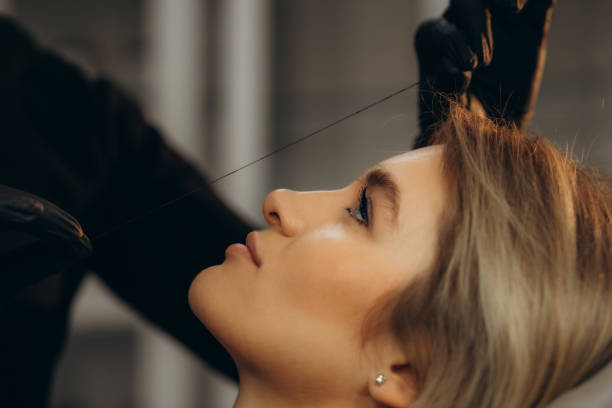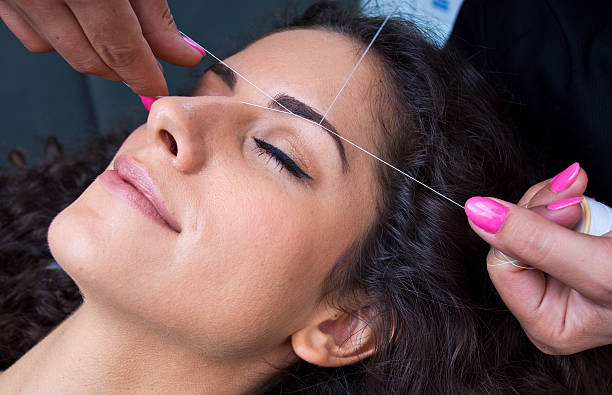When it comes to thick eyebrows, a robust grooming routine is key to achieving the perfect arch and shape. The main question we address in this article is whether waxing or threading offers the best method for taming those lush brows. Both techniques have their loyalists and detractors, and the right choice can leave you with eyebrow goals achieved—shape, definition, and a clean look that enhances your facial features. Here, we delve into the finer points of each approach, helping you make an informed decision for your brow grooming needs.
Understanding Eyebrow Grooming

Grooming your eyebrows is not just about hair removal—it’s a critical component of your facial aesthetics. Thick eyebrows in particular make a statement and require a level of precision to ensure they complement your face shape. The right technique can enhance symmetry, open up the eyes, and even affect how your overall facial expressions are perceived. Moreover, your method of choice must maintain the integrity of the brows’ thickness while sculpting them to perfection.
Waxing for Thick Eyebrows

Waxing involves applying warm wax to the unwanted hair, followed by placing a strip of cloth or paper over it and ripping it away from the skin. For those with thick eyebrows, the process can efficiently remove large areas of hair at once, providing a quick and clear definition. The wax can grab even the smallest hairs, which is beneficial for achieving a smooth, clean brow line with each session.
Pros of Waxing for Dense Eyebrows
Waxing has several advantages for those with denser brows. It’s generally faster than threading, making it ideal for time-saving during salon visits or at-home care. Waxing also tends to be longer-lasting, with results that can keep brows in check for up to six weeks. Additionally, repeated waxing may lead to finer hair growth over time, potentially easing the maintenance of thick eyebrows.
Cons of Waxing for Dense Eyebrows
Despite its benefits, waxing comes with potential downsides for thick eyebrows. It can be less precise than threading, making it a poor choice for intricate shaping. Also, it involves chemicals and heat, which can irritate sensitive skin or cause redness and swelling. There’s also the risk of accidental over-waxing, leading to thinner brows than desired, which is a significant concern for individuals aiming to maintain their thickness.
Threading for Thick Eyebrows
Threading has an ancient history, designed for the meticulous removal of hair using a twisted cotton thread. The technique allows for tight control over the hairs being removed, ensuring high precision perfect for shaping thick eyebrows. It removes hair from the follicle without the need for harsh chemicals or waxes, making it a gentler option for the skin.
Pros of Threading for Dense Eyebrows
One of the most significant advantages of threading is the level of detail it offers. For thick eyebrows with potential for dramatic shapes, threading provides the control needed to carve out your ideal arch. It’s considered kinder to the skin compared to waxing, leaving less redness and irritation in its wake. Lastly, it also has the capability to remove even the shortest hairs, allowing for a cleaner, more polished finish.
Cons of Threading for Dense Eyebrows
Threading is not without its drawbacks. It may be more time consuming, as each hair is removed individually—which can be a deterrent for those with incredibly thick brows seeking a quick fix. Some people also find threading to be more painful, as the sensation of each hair being plucked can be intense. Additionally, locating a skilled threading practitioner may be more challenging, depending on your location.
Comparing Waxing and Threading
Waxing and threading differ in several ways, impacting the longevity of results, the precision achievable, and the level of discomfort experienced during the procedure. Here’s where we offer a side-by-side comparison to weigh the pros and cons of each method.
| Feature | Waxing | Threading |
|---|---|---|
| Duration of Results | Up to 6 weeks | Up to 6 weeks |
| Precision | Good for large areas | Excellent for detail |
| Pain Level | Quick with moderate pain | Individual hairs can be more painful |
Cost Comparison: Which Is More Economical in the Long Run?
Cost is a crucial factor to consider. Generally, threading can be more cost-effective compared to waxing due to the minimal use of materials. Let’s list down the two methods in terms of their potential costs:
- Initial Investment: Threading requires only a skilled practitioner and thread, whereas waxing requires wax, strips, and often after-care products.
- Frequency of Visits: Both methods require similar maintenance schedules, but the cost per visit may vary depending on the salon or practitioner.
Skin Sensitivity and Reactions: What You Need to Know
Your skin’s reaction to different grooming methods is a primary concern. Threading is widely praised for reducing the likelihood of allergic reactions, whereas waxing, with its chemicals and potential for skin pulling, can contribute to sensitivity and additional issues like ingrown hairs.
Personal Preferences and Professional Recommendations
Beauty experts usually abide by the ‘less is more’ principle regarding eyebrow shaping methods. The general recommendation is to choose the least invasive method that meets your grooming goals. Many favor threading for its precision, while others opt for waxing due to the speed and sharp results it can provide, especially for those with thick brows who need a significant amount of hair removal.
Ultimately, the decision often boils down to your personal experience and the way your skin reacts to each method. Consider your pain tolerance, your need for precision, and how your skin tends to react post-procedure. It’s also about the look you’re aiming for—whether you’re going for a sharp, dramatic arch or a more natural, softer shape.
Conclusion
We’ve discussed the features, benefits, and drawbacks of waxing and threading for thick eyebrows. Both have merits that make them viable options, but the best choice for you depends on a variety of factors, from skin sensitivity and precision to cost and personal preferences. It is important to remember that eyebrow grooming is not a one-size-fits-all affair and that it’s worth exploring both methods to discover which suits your needs and leaves your brows looking their best.
Frequently Asked Questions
Q1: Can waxing cause thick eyebrows to become thinner over time?
A1: Waxing pulls out hair from the root, which can result in hair growing back finer or slower over time. However, for most people, this is a gradual change and may not significantly impact the overall thickness of the brows.
Q2: Is threading a better option for people with sensitive skin?
A2: Threading is often recommended for individuals with sensitive skin because it does not involve chemicals and is less likely to cause irritation compared to waxing.
Q3: How long do the results of waxing vs. threading last?
A3: Both waxing and threading generally last between 2-6 weeks depending on individual hair growth cycles, but results can vary from person to person.
Q4: Can I do threading or waxing at home?
A4: While at-home kits are available, for best results and to minimize risks, it is advisable to have these treatments performed by a trained professional, especially for those with thick eyebrows that require careful shaping.
Q5: How can I decide which method is right for me?
A5: Consider factors such as your pain threshold, skin sensitivity, the desired precision, maintenance frequency, and budget. Also, trying both methods at least once can offer personal insight into which suits you better.
